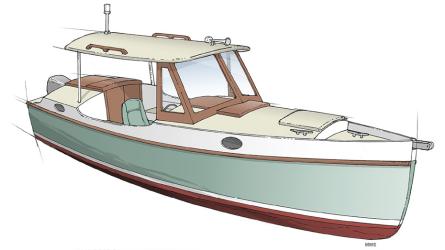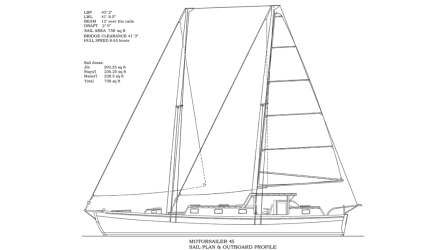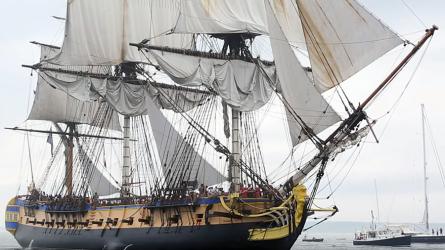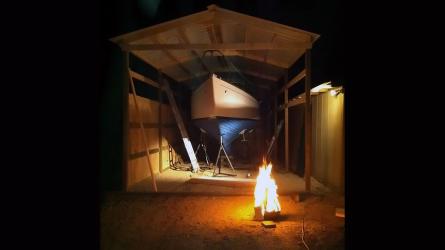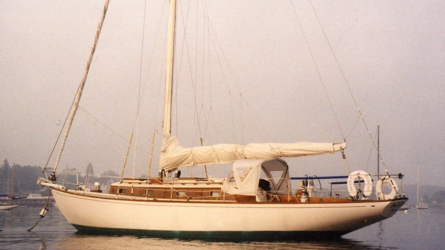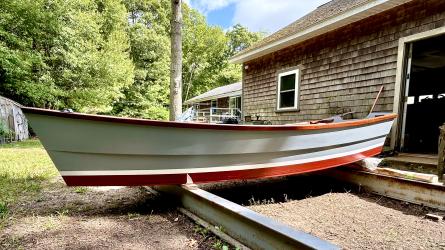Slocum’s Luck
A life of near misses and good fortune
A life of near misses and good fortune
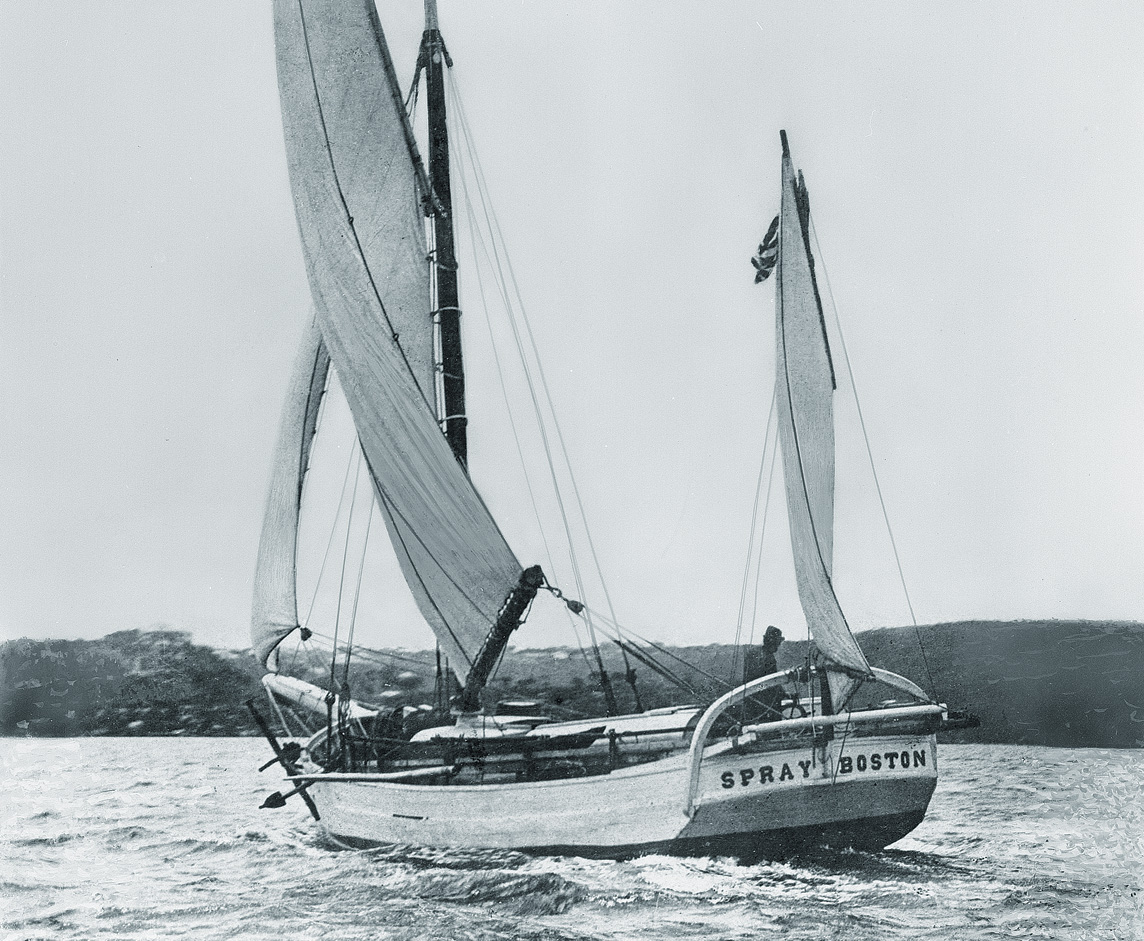
COURTESY THE NEW BEDFORD WHALING MUSEUM
Joshua Slocum’s SPRAY sails near Sydney, Australia, where Slocum was given much-needed new sails during his pioneering solo circumnavigation. Throughout his sailing career, Slocum experienced many fortuitous events and near misses, and came to acknowledge his good fortune as “Slocum’s luck.”
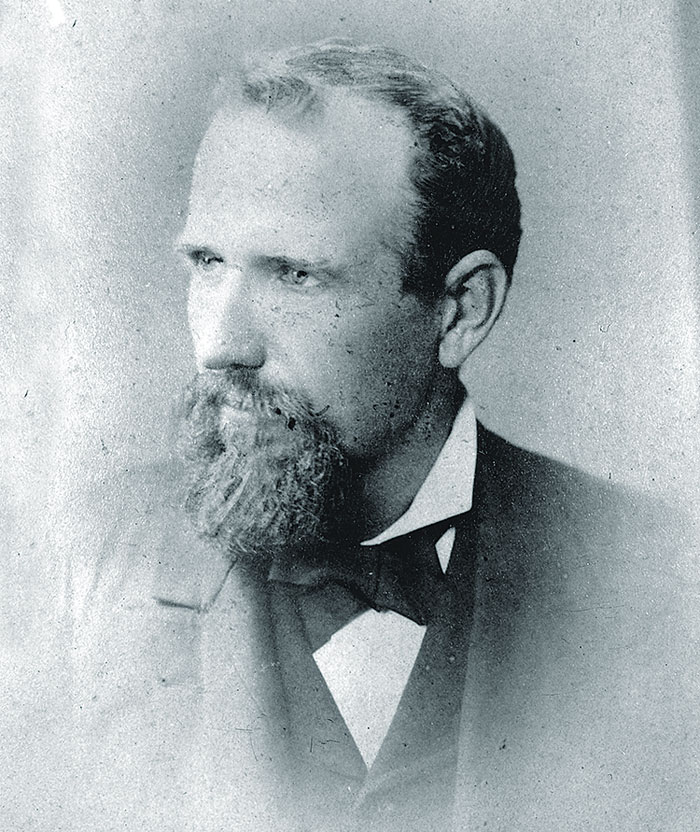
COURTESY THE NEW BEDFORD WHALING MUSEUM
Slocum circa 1883, when he was 39.
Somewhere in the Atlantic Ocean, probably sometime in 1866, a ship named AGRA faces a rising wind. Launched in 1862 at the redoubtable Medford, Massachusetts, yard of J.T. Foster & Co., the 174′ AGRA is still a relatively new vessel. She is of a type known as a “moderate clipper,” designed to carry more cargo at some sacrifice in speed compared to the “full” clippers, whose heyday is all but finished. Still, AGRA can move. She has turned in runs of 350 miles per day, only about 50 miles less than the fastest clipper ships. Now, as the wind gusts become stronger, Capt. Shaw tells his mate it is time to reduce sail. The crew is ordered aloft and one of them, a young seaman named Joshua Slocum, begins climbing nimbly to AGRA’s main upper topsail yard.
In April 1895, some 30 years after he scampered aloft that day, Slocum told a Boston Herald reporter the shocking thing that happened to him. He “was gathering in the sail, when a gust struck him, and pitched him off. His fall was broken and his life saved by collision with the main yard, which he struck on his head, cutting a gash over his left eye, which is the only mark of disfigurement on his face.”
Thanks to his 1895–98 solo circumnavigation in his 36′9″ sloop SPRAY and his 1900 book about the experience, Sailing Alone Around the World, Slocum would become a famous man, and he was called upon at times to sit for a portrait. When he did so, Slocum usually, though not always, presented his scar-free right side to the camera. One can only guess what Slocum thought about as he awaited the shutter’s click. That he’d made his remarkable voyage in what then seemed to most people to be a foolishly small boat was confirmation of his superior seamanship. But, deep down, Joshua Slocum knew that something else lay behind a portion of his success. Starting with that frightening fall aboard AGRA that should have ended his life, Slocum had always sailed with an angel upon his shoulder. As the years passed and the near-misses multiplied, he gave his good fortune, his angel, a name. He called it “Slocum’s luck.”
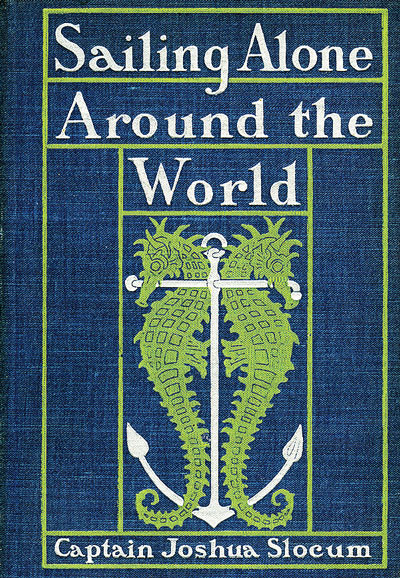
Published in March 1900, the beautiful first edition of Slocum’s Sailing Alone Around the World sold quickly.
One wouldn’t think that Slocum, with his innate and highly developed skills as a seaman, boat handler, and shipmaster, ever had to count on fickle luck. He was the prototypical self-reliant, self-made man. Ever since he’d embarked on his first voyage before the mast aboard a lumber carrier sailing from Saint John, New Brunswick, to Dublin, Ireland, Slocum had relied upon his intelligence, physical toughness, strict sobriety, and a growing mastery of the sextant and mathematics to claw his way from the fo’c’s’le to the captain’s quarters. He was the perfect example of the sort of man who made his own luck. Nobody knew this better than Slocum himself. “I had studied the sea as perhaps few men have studied it, neglecting all else,” Slocum wrote in the fourth paragraph of Sailing Alone Around the World.
He wasn’t kidding.
Slocum’s intimate feel for the world’s oceans, seas, gulfs, and bays was so highly developed that he was able to recognize when he had entered a specific current within his watery world. To cite but one example, as he approached Brazil in SPRAY when he was homeward bound in May 1898, Slocum wrote in Sailing Alone that “Strange and long-forgotten current ripples pattered against the sloop’s sides…. By these current ripples I was assured that she was now off St. Roque and had struck the current which sweeps around that cape.” His inner clock and knotmeter told him his patent log was giving wrong information, so he hauled in the log’s spinner and checked it, and indeed one of the blades had been crushed—by a “monster” shark no doubt. (Slocum was both fearful of and ruthless about sharks, luring them to his boat and killing them when he could.)
Slocum could read wave patterns and tell what they meant, those ceaseless, rolling messages that reached him from afar. He understood the barometer and pelagic birds and what each foretold. He was an interpreter of clouds. “To know the laws that govern the winds, and to know that you know them, will give you an easy mind on your voyage round the world; otherwise you may tremble at the appearance of every cloud.”
And yet, despite all his knowledge and skill, there were times when only Slocum’s luck, such as his fortuitous collision with the AGRA’s main yard, coupled with catlike reflexes and powerful hands, saved the day. In 1865, having sailed before the mast from Boston to Hong Kong aboard TANJORE, Slocum was struck down by malaria. Although blessed with a disease-resistant constitution, Slocum became seriously debilitated in Hong Kong and entered a hospital there. Although he recovered enough strength to rejoin his ship when it departed for Batavia (now Jakarta, Indonesia), the fever returned. Slocum, who was then 21 years old, had to leave TANJORE and enter another hospital.
“It is the mark of an inexperienced man not to believe in luck.” — Joseph Conrad
Now, Slocum found himself weakened and alone in what his first-born son, Victor, later called “that pest hole of the Dutch East Indies.” He might have died there had luck not intervened in the person of a man Victor identified only as “Capt. Airy of the steamship SOUSHAY.” Slocum himself mentioned Airy in Sailing Alone, calling him a “good man.” But neither father nor son shared what quirk of fate brought Airy to the hospital where he met the debilitated young Joshua, and took him—“hove down with fever”—aboard his steamship.
Aboard SOUSHAY, as she plied the Java Sea, Banda Sea, Arafura Sea, and Torres Strait—waters he would come to know well as a merchant captain—Slocum began a slow recovery. He had so little strength, though, that when the SOUSHAY called at Booby Island off the north Australian coast, Slocum had to literally crawl on deck to see the fabled place for himself.
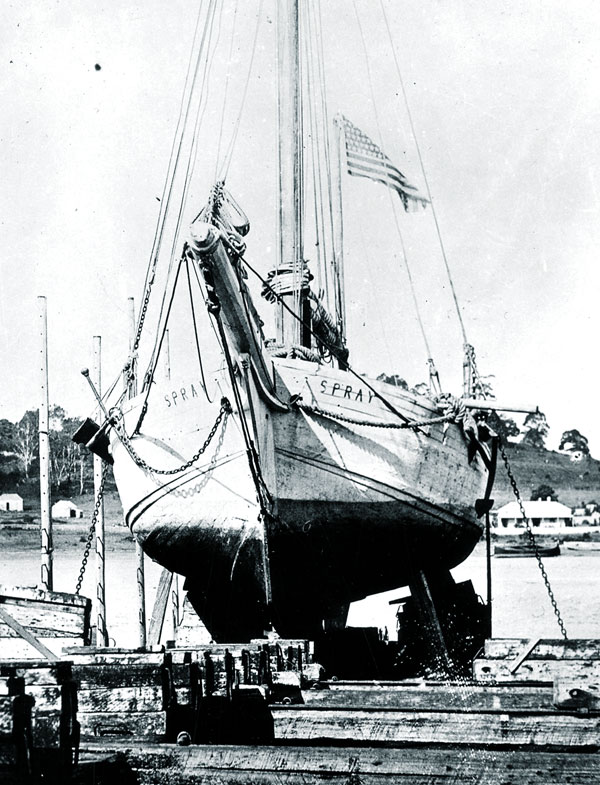
PHOTO BY W. AIKENHEAD; COURTESY OF THE NEW BEDFORD WHALING MUSEUM
SPRAY received some bottom repairs and a fresh coat of antifouling paint at Devonport, Tasmania, in February 1897.
After his initial recovery from malaria—he later told his publisher that he suffered “years of broken health”—Slocum eventually achieved his goal of becoming a merchant ship captain. For the next 19 years or so—roughly 1869 to 1888—Slocum had ample chances to display his hard-won knowledge of ocean winds, currents, and ship handling while making passages all around the globe. As a ship owner, he brought his vessels—PATO, AMETHYST, NORTHERN LIGHT, AQUIDNECK—through terrible storms. Sometimes, the situation involved such danger that he placed his family in provisioned boats in case it became necessary to abandon ship.
Throughout that period, it was Slocum’s seamanship and navigational genius that consistently brought him safely into port. Yet, there was a factor of pure luck, too, and it could emerge in odd ways that might sometimes have as much to do with profit as survival. In 1877, aboard his 72′ schooner PATO, Slocum made a cod-fishing expedition to Russian waters in the Sea of Okhotsk. There, his crew landed so many fish that they ran out of salt, the key preservative. But just as they were about to be forced to abandon further efforts on that rich fishing ground, Slocum encountered a vessel he knew well: CONSTITUTION, Slocum’s first square-rig command when he’d lived in San Francisco seven years earlier. It was preparing to jettison its excess salt and head home. Instead, the salt was transferred to PATO, which enabled Slocum to complete filling his ship’s hold and sail to Portland, Oregon, where he reaped a good profit from his catch.
What but Slocum’s luck could ever account for his safe passage in 1883 through the Sunda Strait—the body of water separating the islands of Java and Sumatra and connecting the Java Sea with the Indian Ocean? Victor Slocum, who was 12 at the time, remembered NORTHERN LIGHT sailing through the strait with two other vessels in line behind. Victor never forgot his astonishment at seeing the square-rigged WM. H. BESSE, under full sail, shudder to a complete stop in what should have been deep water. It was a mysterious prelude to one of the greatest natural disasters in recorded history.
“She had grounded on a reef which had been cast up by submarine volcanic action in the very spot over which we had passed but a quarter of an hour before. The sea was trembling and in bubbles. A lead that was cast came up from the bottom so hot that it melted out the tallow,” which filled the hollowed-out bottom of the sounding lead in order to bring up a sample of the bottom to show whether it was mud or sand. “The NORTHERN LIGHT braced her yards and came up into the wind, but as the BOURNE came up astern of the BESSE and hove to, to offer assistance, we kept off again for Anjer, which was by this time but a few miles distant.”
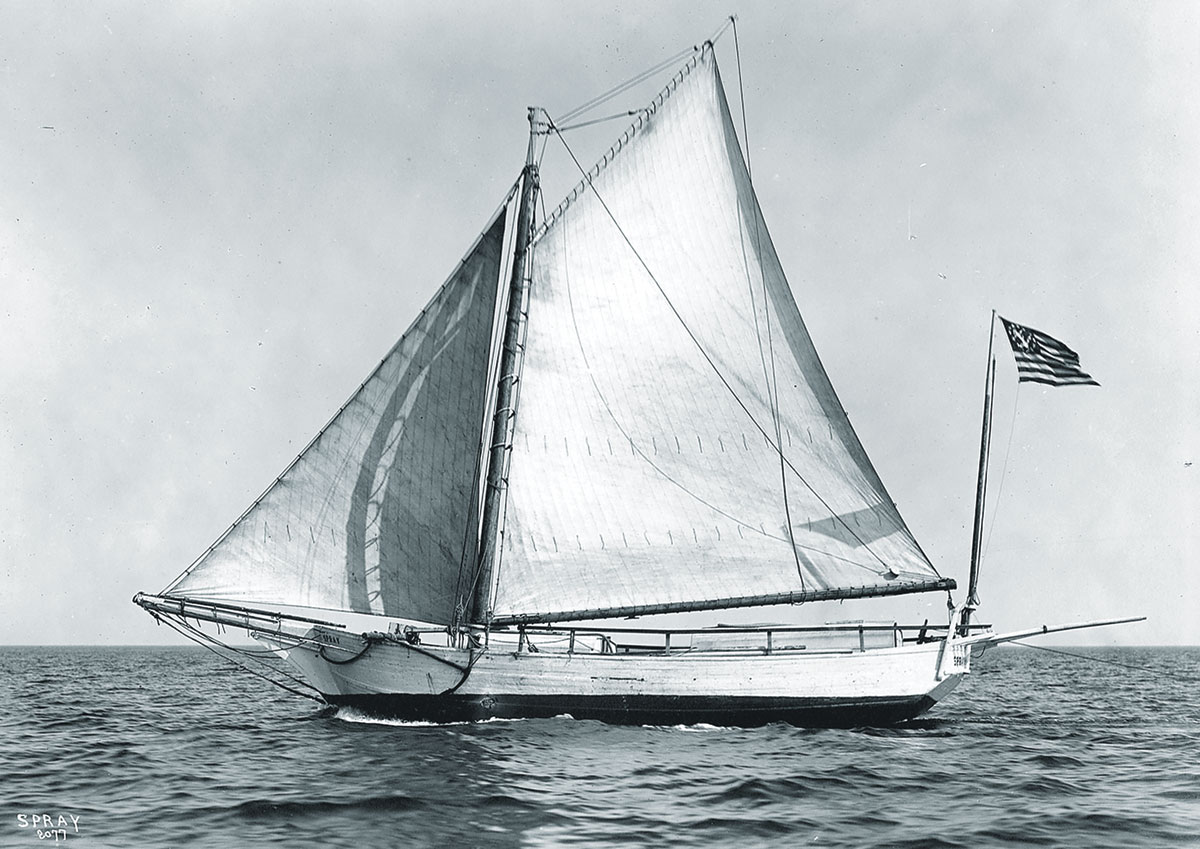
WILLARD B. JACKSON/HART NAUTICAL COLLECTIONS
Slocum delighted in demonstrating his boat’s course-holding ability, as he is doing here off Marblehead, Massachusetts, for photographer Willard B. Jackson.
Slocum stopped at Anjer, known more generally now as Anyer, and then an important Indonesian port, where he learned that the WM. H. BESSE would need to be towed to Batavia for repairs that would take several weeks. Upon sailing from Anjer, the NORTHERN LIGHT passed the volcanic island Krakatoa, which Victor Slocum wrote “was in the awful majesty of full eruption…. Here a bright fire burned, throwing up a column of black steam and ashes which reached a culminating altitude of seventeen miles by sextant measurement. The fall of ashes made the sea all about white with pumice stone. For days after passing it was washed upon our deck by the lively sea.”
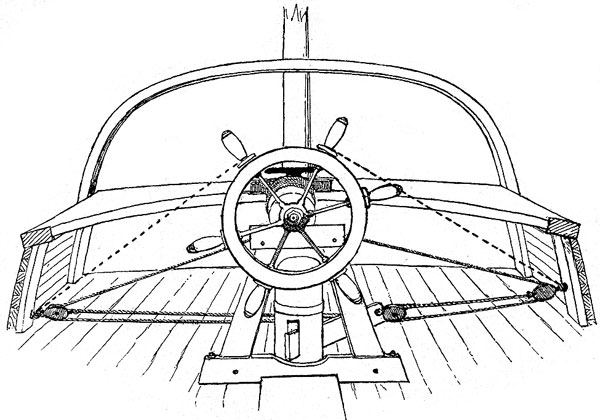
WILLARD B. JACKSON/HART NAUTICAL COLLECTIONS
Steering was by a block-and-tackle arrangement; the dotted lines represent ropes used to lash the wheel once the sails had been trimmed and the course was set.
But neither Victor nor his father had any idea that what they saw was in no way a “full eruption.” Krakatoa exploded a few days later on August 26, 1883, with what was said to have been the loudest sound ever heard on the planet. About two-thirds of Anjer disappeared. Tsunamis followed. Ships were carried a mile into jungles, and an estimated 36,000 people were killed. Many years later, Victor’s younger brother, Ben, wrote to Slocum biographer Walter Teller, observing that, “Had we been three days later in that region we would have been suffocated by the fumes.”
As the years passed, it was inevitable that Slocum’s luck would sometimes desert him. The vagaries of mechanical failures were always a threat. When the rudderhead of NORTHERN LIGHT twisted off during a storm off the South African coast, much of the valuable cargo had to be jettisoned to keep the vessel upright as she flooded and the pumps couldn’t keep up.
Finally, there came a day in late December 1887 when a fatal combination of current, wind, and a sandbar overcame all of Slocum’s experience and skill. While attempting to make his way out of Brazil’s Paranaguá Bay in his 138′ bark AQUIDNECK, Slocum ran aground after a failed effort to bring the square-rigger about. The uninsured vessel, of which Slocum was sole owner, was soon rendered unfit for anything but conversion to a shabby coal barge.
Although Slocum couldn’t have known it at the time, the loss of the AQUIDNECK marked the end of his merchant seafaring career. The grounding also left 43-year-old Slocum stranded in Brazil, nearly broke yet responsible for getting himself, his 26-year-old second wife, Hettie (Slocum had remarried following the death of his beloved first wife, Virginia), and his sons Victor and Garfield back to the United States. Slocum’s response was not to purchase steamship tickets but instead to build a 35′ boat and sail back, a voyage of some 5,500 miles completed between June 1888 and December 1889. Slocum would recount this adventure in 1890 in his self-published Voyage of the Liberdade. In designing and building LIBERDADE he was inspired by Chinese sampans and Cape Ann dories, but he always called her a canoe. She provided several examples of Slocum’s luck.
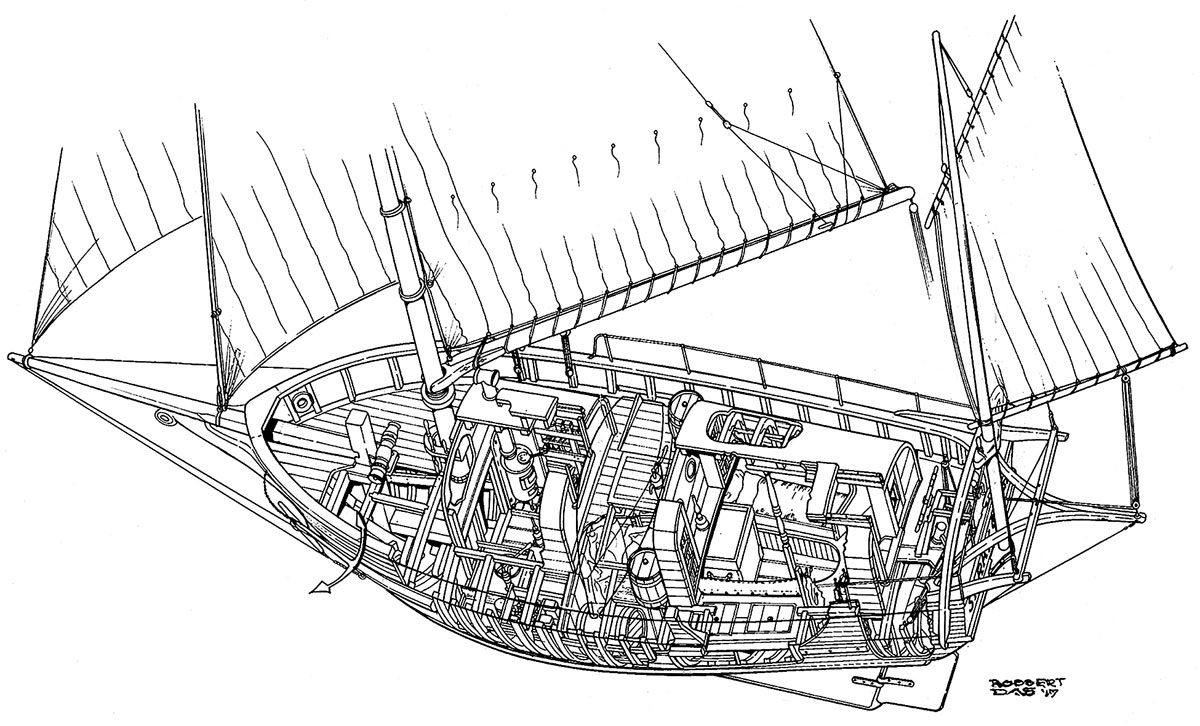
COURTESY OF ROBBERT DAS
This evocative cutaway illustration of SPRAY shows the boat as imagined by Dutch artist Robbert Das. Slocum’s cabin is aft, separated from the forward cabin by the hold that contained water casks and assorted gear. Eventually, Slocum used the hold to stow seashells he sold to visitors. On the bulkhead of Slocum’s cabin are shelves for his many books.
Twice during the journey, LIBERDADE narrowly avoided grounding in circumstances that could have been fatal. Caught in a southeast gale somewhere between Cape St. Roque and the Amazon delta, Slocum sought safety closer inshore. In doing so, he sailed right over a shoal. Slocum said the waves “bellowed over the shoal! I could smell the slimy bottom of the sea, when they broke! I could taste the salty sand…. This was the greatest danger we had yet encountered. The elasticity of our canoe, not its bulk, saved it from destruction.”
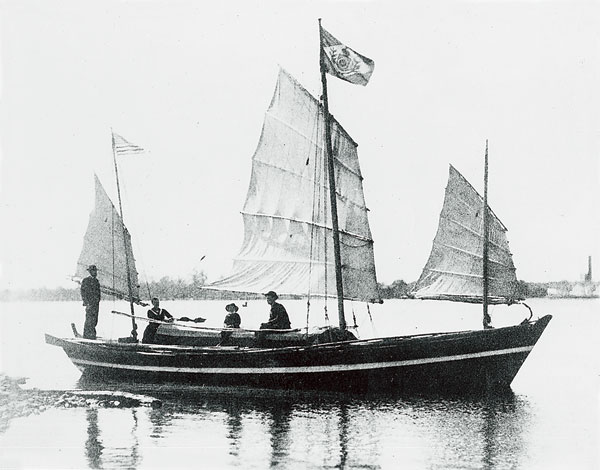
COURTESY OF THE NEW BEDFORD WHALING MUSEUM
The Slocums aboard LIBERDADE, probably at Washington, D.C., in the spring of 1889. A Brazilian flag flies from the mainmast. The boat’s small, easily reefed junk-style sails were quickly adaptable to varying wind strengths.
A not-dissimilar event unfolded later off the North Carolina coast. Caught in a gale to seaward of the bar at New River, he decided to seek refuge. Twenty-one years after the event, Hettie wrote about it in a letter to a friend: “We went through drawing 2 feet 4 inches of water where at ordinary time it was a rare thing to have more than twelve inches. We were very glad for we had already had enough of it outside.”
In 1888, the long, narrow segment of what would eventually become the Intracoastal Waterway connecting New River to Bogue Sound to the northeast was merely a ditch usable only by shoal-draft small craft when the tide served. But after his recent experience offshore, and perhaps at Hettie’s urging, Slocum now planned to somehow get LIBERDADE through this sheltered inland route. However, the channel markers that delineate the waterway today weren’t there to guide him. He wrote: “I was getting lost in the maze of sloughs and creeks, which as soon as I entered seemed to lead in every direction but the right one.”
Then Slocum’s luck came to the rescue when they encountered a hunter whose grandfather had dug the ditch and who knew it well. “A bargain was quickly made, and my pilot came aboard…. The entrance to the ditch, then close by, was made with a flowing sheet [the sheets being eased with wind abeam or over the stern quarter], and I soon found that my pilot knew his business.”
Had it not been for Slocum’s luck, SPRAY, among the most famous of sailboats, might have been lost before setting off on the great voyage. In a letter to Walter Teller written in 1954, Slocum’s youngest son, Garfield, described an event that might have ended the SPRAY’s career almost as soon as it began. Garfield wrote of a cruise he made with his father to Maine in SPRAY, probably in 1894 when he was about 13 years old.
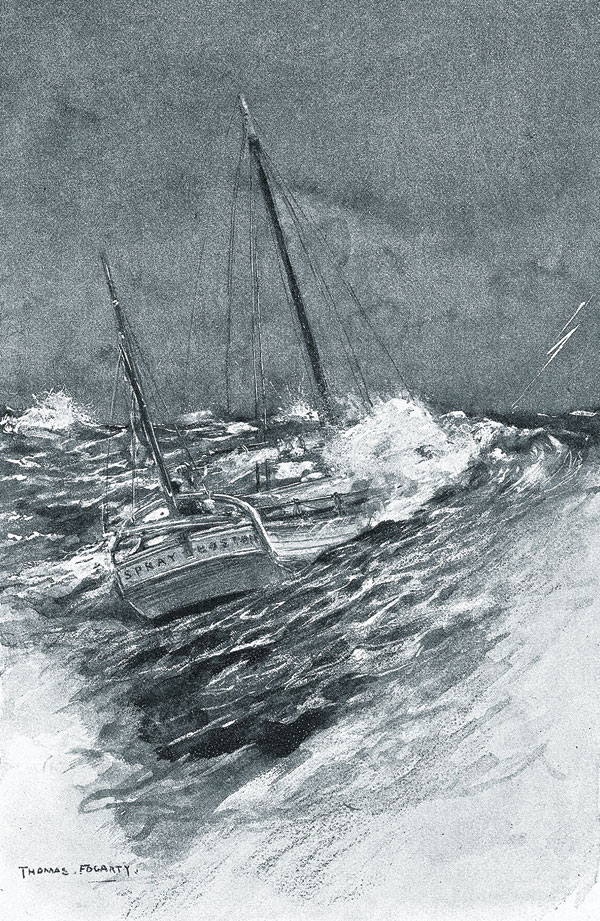
COURTESY OF TILBURY HOUSE PUBLISHERS AND THE NEW BEDFORD WHALING MUSEUM
Thomas Fogarty’s illustration “Storm off New York” shows SPRAY lying to her sea anchor with sails lowered and lightning flashing—the last ordeal of the voyage.
While leaving what was most likely Pemaquid Beach, Slocum attempted to make his way past a ledge in light air. It was a situation that any sailor of an engineless boat today would understand and find worrisome. Garfield remembered: “As the SPRAY almost passed a ledge on the leeward, the powerful undertow lifted her and dropped her on the ledge. The waves tried to finish the SPRAY. Some help came quickly to our aid by land and sea. Father threw a coil of rope to some men on shore. He tied me under my armpits, held one end of the rope, and told me to jump. The men pulled me to high ground. Other men, in dories, got the SPRAY off, and towed her to a place where father repaired her bottom.”
Slocum presumably entered this event in SPRAY’s log, although he saw no reason to discuss it anywhere else. But he must have recognized the grounding as potentially fatal, since he took the desperate measure of having Garfield hauled ashore through the frigid Maine water. Perhaps there was a reasonably heavy swell that posed a real threat to the boat, and to him as well, for he could not swim. Slocum owed a lot to those Maine fishermen who luckily happened to be present. One suspects that they took the whole event as nonchalantly as he did.
But nobody was present on the night of December 11, 1895, when Slocum mistook vast, moonlit sand dunes on the Uruguayan coast for ocean swells. It was a very rare miscalculation that put SPRAY hard aground on a sandbar about 7 miles south of the Brazilian border. With his boat exposed to ocean swells, Slocum managed to launch his half-dory tender. His plan was to row out and drop a kedge anchor in preparation for the next high tide.
But carrying a heavy anchor and 240′ of cable through the surf was a precarious task. SPRAY’s tender—a dory that Slocum had acquired and cut in half in Gloucester—shipped water and was in danger of sinking by the time Slocum lifted the big anchor and tossed it into the sea. He did so “just as [the half-dory] was turning over…. I suddenly remembered I could not swim.” Three times he tried and failed to right his little boat and clamber in without capsizing it again. On his fourth attempt he finally managed it. Now, though, he realized that the current was carrying him offshore and he was in a battle for his life.
What saved Slocum, after getting back into the boat and bailing it, was that he’d managed to recover one of his oars. After attaching a second anchor cable to the buoyed end of the first one, he had exactly enough length to take a single turn around the SPRAY’s windlass. Slocum might have planned it that way, but he well knew that Slocum’s luck had seen him through yet again.
A briefer yet potentially even more dangerous grounding occurred after Slocum sailed from Cooktown, Australia, on June 6, 1897, to begin his long passage across the Indian Ocean to South Africa. On the night of June 8, after leaving the M Reef lightship astern, SPRAY, “going at full speed, with sheets off she hit the M Reef itself on the north end, where I expected to see a beacon.” Had the beacon been operating, Slocum certainly would have seen it. In its absence, Slocum’s luck saved him once more: “She swung off quickly on her heel, however, and with one more bound a swell cut across the shoal point so quickly that I hardly knew how it was done…. I saw the ugly boulders under the sloop’s keel as she flashed over them.…”
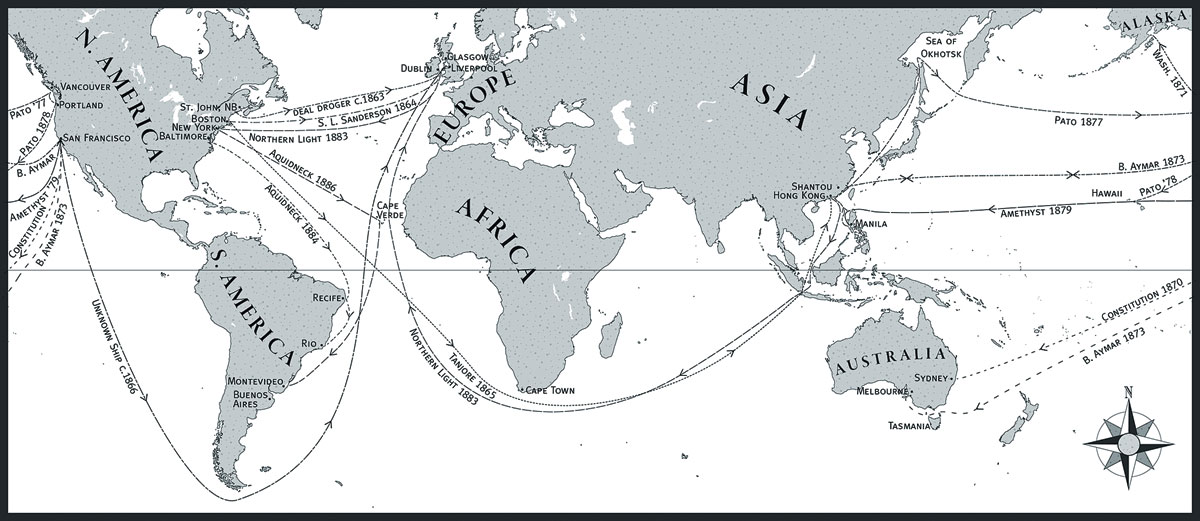
COURTESY OF TILBURY HOUSE PUBLISHERS AND THE NEW BEDFORD WHALING MUSEUM
Selected voyages of Joshua Slocum, circa 1863–86. Though not a complete record of Slocum’s travels as a merchant seaman and captain, the map shows the many ports of call of a sailor intimately familiar with the world’s oceans. The course lines are approximations.
In Sailing Alone, Slocum attempted to ascribe this escape not merely to his usual good fortune but in this particular instance to what he claimed was his lucky number: “…I made a mental note of it that the letter M, for which the reef was named, was the thirteenth one in our alphabet, and that thirteen, as noted years before was still my lucky number.”
However, Slocum didn’t share with readers what he meant by his reference to “years before.” Nor did his editors at The Century Company, publisher of Sailing Alone, query him about it. He was referring to his self-published Voyage of the Destroyer. This little book recounted his experience during the period of December 1892 to April 1893, as “navigator in command” of an ironclad warship that was being towed from New York to Brazil. Slocum wrote that DESTROYER’s crew was composed of “twelve brave fellows.” Adding himself to that number brought the total aboard to 13. “Curiously enough,” he wrote, “that fatalistic number (thirteen) was not thought of before sailing.”
The DESTROYER voyage was grueling for all aboard except for the ship’s rats, which, apparently divining what was about to transpire, had abandoned ship. The vessel had been intended for harbor defense only and, when subjected to open-ocean stresses for which she had not been designed, her riveted seams opened up. Slocum and the crew survived only by dint of continuous and exhausting pumping—and Slocum’s luck.
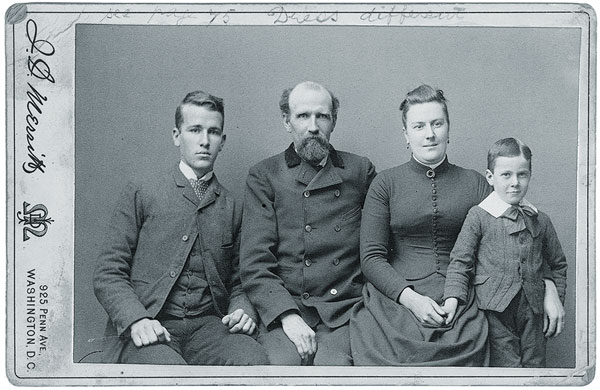
COURTESY THE NATIONAL PORTRAIT GALLERY, SMITHSONIAN INSTITUTION
With the LIBERDADE voyage completed, the Slocums sat for a portrait at the Washington, D.C., studio of J.D. Merritt. From left to right are Victor, Joshua, Hettie, and Garfield.
In the end, of course, Slocum’s luck finally ran out. Because the famous captain simply disappeared, speculation about the time, place, and manner of his going was as inevitable as it was inconclusive. Knowledgeable men who visited SPRAY toward the end—yachting writer H.S. “Skipper” Smith and naval architect Charles Mower among them—suggested structural failure may have been to blame.
Slocum’s sons Victor and Ben each had theories about what might have happened. Ben believed that his father, heartbroken and lonely ever since the death of his first wife and soul mate, Virginia, in 1884, finally let the sea take him. Victor posited that SPRAY was run down by a steamship.
In fact, only Slocum’s luck had saved him from being run down by a swift, silent sailing ship at night while crossing the Atlantic from Gibraltar to South America on SPRAY’s outbound journey. Collision at night, among a single-hander’s worst fears, is the scenario claimed for SPRAY’s disappearance by the Boston chronicler of New England lighthouses and maritime history, Edward Rowe Snow. In an article published in the Quincy Patriot Ledger on April 8, 1959, Snow wrote:
One of the world’s greatest sea mysteries, the loss of the SPRAY…may have been solved…by the disclosure that Capt. Joshua Slocum, who vanished at sea in 1909, may have been run down by a steamer off of the Lesser Antilles within a relatively few hours after he had left the home of a farmer in the vicinity.
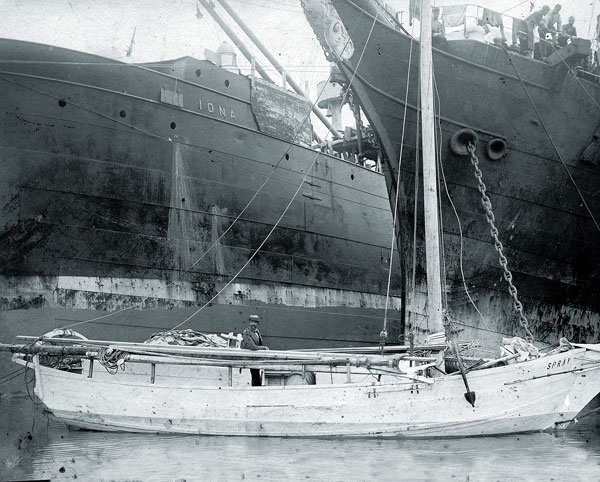
COURTESY THE NEW BEDFORD WHALING MUSEUM
This photograph was probably taken in the harbor at Recife, Brazil, in October 1895, when Slocum had just completed his Atlantic crossing from Gibraltar. The trip included a dangerous encounter with pirates during which SPRAY’s boom was broken; it also included a near-collision with a sailing ship at night. The repairs were incomplete when this image was made.
Snow’s source was Capt. Charles H. Bond, “a master mariner whose background and references are such to make his statements unimpeachable.” Nobody involved in the story who might have been affected by what Bond’s source revealed was still alive, so there was no longer any reason to hush up the matter. Bond’s source, the “farmer” mentioned in the article, had visited Slocum when SPRAY called at Turtle Island (Tortuga) off the northwest coast of Haiti. This farmer, Felix Meinickheim, boarded a local steamship not long after Slocum had sailed and noticed deep gouges in the vessel’s bow.
Although the ship’s captain admitted to Meinickheim that they had run down a native craft at night, but hadn’t stopped, the second mate told a somewhat different story. He said the vessel they had struck was not native to the area and, even more telling, that there was nobody at the wheel. Since Slocum generally took advantage of SPRAY’s self-steering ability to rest, read, and sleep, this last detail is a chilling clue that Snow’s report could be true. If so, Slocum’s luck deserted him for the last time in the darkness of a Caribbean night. The irony that it was a steamship would not have been lost on Slocum, who had steadfastly refused to abandon sail. “Steam,” he once told one of his sons, “was fine for others” but not for him. 
Stan Grayson is a regular contributor to WoodenBoat. His newest book, A Man for All Oceans: Captain Joshua Slocum and the First Solo Sail Around the World (Tilbury House Publishers and the New Bedford Whaling Museum), will be published in June and available from The WoodenBoat Store (www.woodenboatstore.com). A review appears on page 116.
